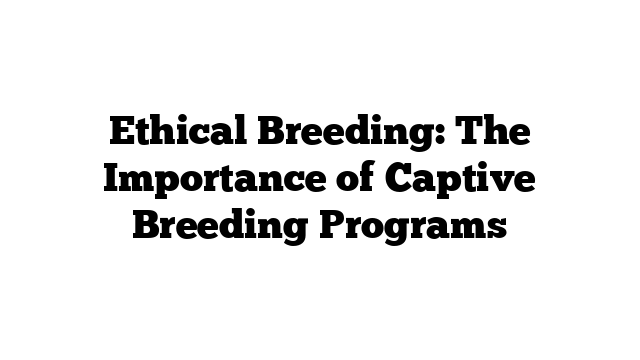Introduction
Captive breeding programs have gained significant attention in recent years as a vital tool for the conservation and preservation of endangered species. These programs involve breeding and raising rare animal species in controlled environments such as zoos, aquariums, and specialized facilities. While the practice of captive breeding has received both praise and criticism, it remains a crucial aspect of conservation efforts worldwide. This article will explore the importance of captive breeding programs and discuss their ethical considerations.
Preservation of Genetic Diversity
One of the primary goals of captive breeding programs is to preserve and maintain genetic diversity within endangered species populations. In the wild, species may face various threats such as habitat loss, poaching, and climate change, which can lead to a reduction in genetic diversity. By breeding animals in captivity, conservationists can ensure the production of healthy and genetically diverse offspring.
Maintaining genetic diversity is crucial for the long-term survival and adaptability of species. It allows populations to have a higher chance of adapting to changing environmental conditions, such as disease outbreaks or changes in climate. Captive breeding programs can help prevent inbreeding, which can lead to the accumulation of harmful genetic mutations and reduce the fitness of offspring. By carefully managing breeding pairs and genetic records, conservationists can avoid inbreeding and maintain healthy genetic diversity.
Species Reinforcement and Reintroduction
Captive breeding programs play a vital role in reinforcing existing populations of endangered species and reintroducing animals into their natural habitats. These programs aim to increase the population size of endangered species and bolster their chances of survival in the wild. Animals raised in captivity are often provided with optimal healthcare, nutrition, and protection, ensuring they are in good health and well-prepared for release.
Reintroduction efforts involve carefully selecting animals from captive populations and gradually acclimatizing them to their natural habitats. This process typically involves teaching them essential survival skills and monitoring their progress to ensure their successful integration into the wild population. Reintroduction programs can help restore species to their historical habitats and contribute to ecosystem restoration.
Public Education and Awareness
Captive breeding programs also play a crucial role in educating the public about endangered species and their conservation needs. Zoos, aquariums, and other facilities that participate in captive breeding often serve as educational centers, providing visitors with firsthand experiences and information about rare and endangered species. These educational programs help raise awareness about the threats facing these species and inspire individuals to take action for their conservation.
By providing opportunities for people to observe and learn about endangered species up close, captive breeding programs instill a sense of empathy and responsibility in visitors. This increased awareness can lead to improved public support for conservation efforts, including habitat preservation, legislation, and fundraising for conservation organizations.
Research and Conservation Science
Captive breeding programs also contribute to scientific research and conservation efforts. By studying captive populations, scientists can gain insights into the biology, behavior, and reproductive patterns of endangered species. This knowledge can inform conservation strategies, improve breeding techniques, and aid in the development of effective management plans for both captive and wild populations.
Additionally, captive breeding programs can serve as “insurance populations” in case of catastrophic events that may wipe out entire wild populations. These programs provide a safety net to prevent the extinction of endangered species, allowing time for conservation efforts to address threats in the wild and potentially restore habitats.
Ethical Considerations
While captive breeding programs have many advantages, ethical considerations must be taken into account. It is essential to prioritize the welfare of the animals involved and ensure that their physical and behavioral needs are met. Conservation organizations must provide proper housing, adequate veterinary care, and enrichment opportunities to ensure the well-being of animals in captivity.
Furthermore, it is important to maintain transparency and public trust in captive breeding programs. Organizations should prioritize transparency in their operations, including accurate record-keeping, genetic management, and clear communication with the public. The ultimate goal should be to work towards reintroducing captive-bred animals into the wild whenever possible, rather than perpetually relying on captive populations.
Conclusion
Captive breeding programs play a critical role in the conservation and preservation of endangered species. By preserving genetic diversity, reinforcing populations, educating the public, advancing scientific research, and serving as a safety net, these programs contribute significantly to the long-term survival of endangered species. However, it is essential to conduct captive breeding ethically and prioritize the well-being of the animals involved. By striking a balance between conservation objectives and animal welfare, captive breeding programs can continue to make a positive impact in the field of conservation.
